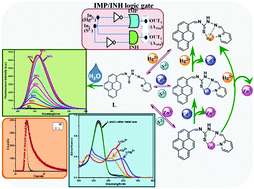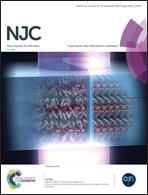A multi-responsive thiosemicarbazone-based probe for detection and discrimination of group 12 metal ions and its application in logic gates†
Abstract
A new simple 3-in-1 multi-response thiosemicarbazone-based chemosensor has been synthesized and characterized. The probe not only exhibited high sensitivity towards the most familiar and abundant group 12 metal ions, viz., Zn2+, Cd2+ and Hg2+, in MeCN–H2O (1 : 1, v/v) medium but also can efficiently distinguish them through significant changes in their absorption and emission spectral behavior. The selectivity response was found to follow the order Hg2+, Cd2+, Zn2+ due to the different degrees of stability of their respective complexes, which was further established by TDDFT calculations and interference studies. The binding affinities of the probe towards these metal ions were investigated by absorption, fluorescence emission, fluorescence lifetime, mass spectral and 1H NMR spectral measurements. The effects of solvent polarity on the probe molecule were also examined. Due to the observation of different binding affinities and the ensuing significant changes in absorbance at different wavelengths by a combination of different inputs, L can be judiciously applied for the construction of some basic logic gates (AND, OR, NOT, IMPLICATION and INHIBIT).



 Please wait while we load your content...
Please wait while we load your content...